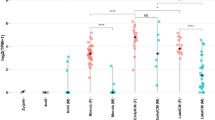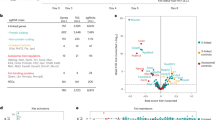Abstract
X inactivation is the means of equalizing the dosage of X chromosomal genes in male and female eutherian mammals, so that only one X is active in each cell. The XIST locus (in cis) on each additional X chromosome initiates the transcriptional silence of that chromosome, making it an inactive X. How the active X in both males and females is protected from inactivation by its own XIST locus is not well understood in any mammal. Previous studies of autosomal duplications suggest that gene(s) on the short arm of human chromosome 19 repress XIST on the active X. Here, we examine the time of transcription of some candidate genes in preimplantation embryos using single-cell RNA sequencing data from human embryos and qRT-PCR from bovine embryos. The candidate genes assayed are those transcribed from 19p13.3-13.2, which are widely expressed and can remodel chromatin. Our results confirm that XIST is expressed at low levels from the future active X in embryos of both sexes; they also show that the XIST locus is repressed in both sexes when pluripotency factors are being upregulated, during the 4–8 cell and morula stages in human and bovine embryos – well before the early blastocyst (E5) when XIST on the inactive X in females starts to be upregulated. Our data suggest a role for DNMT1, UHRF1, SAFB and SAFB2 in XIST repression; they also exclude XACT and other 19p candidate genes and provide the transcriptional timing for some genes not previously assayed in human or bovine preimplantation embryos.
This is a preview of subscription content, access via your institution
Access options
Subscribe to this journal
Receive 12 print issues and online access
$259.00 per year
only $21.58 per issue
Buy this article
- Purchase on Springer Link
- Instant access to full article PDF
Prices may be subject to local taxes which are calculated during checkout



Similar content being viewed by others
Data availability
All data can be found within this published article and its supplementary files.
References
Lyon MF. Sex chromatin and gene action in the mammalian X-chromosome. Am J Hum Genet. 1962;14:135–48.
Brown CJ, Hendrich BD, Rupert JL, Lafrenière RG, Xing Y, Lawrence J, et al. The human XIST gene: analysis of a 17 kb inactive X-specific RNA that contains conserved repeats and is highly localized within the nucleus. Cell 1992;71:527–42.
Yu B, van Tol HTA, Stout TAE, Roelen BAJ. Initiation of X chromosome inactivation during bovine embryo development. Cells. 2020;9:1016.
Lee JT, Jaenisch R. Long-range cis effects of ectopic X-inactivation centres on a mouse autosome. Nature 1997;386:275–9.
Wutz A, Rasmussen TP, Jaenisch R. Chromosomal silencing and localization are mediated by different domains of Xist RNA. Nat Genet. 2002;30:167–74.
Yen ZC, Meyer IM, Karalic S, Brown CJ. A cross-species comparison of X-chromosome inactivation in Eutheria. Genomics 2007;90:453–63.
Migeon BR, Kazi E, Haisley-Royster C, Hu J, Reeves R, Call L, et al. Human X inactivation center induces random X chromosome inactivation in male transgenic mice. Genomics 1999;59:113–21.
Czermiński JT, Lawrence JB. Silencing Trisomy 21 with XIST in neural stem cells promotes neuronal differentiation. Dev Cell. 2020;52:294–308.e3.
Migeon BR, Chowdhury AK, Dunston JA, McIntosh I. Identification of TSIX, encoding an RNA antisense to human XIST, reveals differences from its murine counterpart: implications for X inactivation. Am J Hum Genet. 2001;69:951–60.
Migeon BR, Lee CH, Chowdhury AK, Carpenter H. Species differences in TSIX/Tsix reveal the roles of these genes in X-chromosome inactivation. Am J Hum Genet. 2002;71:286–93.
Migeon BR, Pappas K, Stetten G, Trunca C, Jacobs PA. X inactivation in triploidy and trisomy: The search for autosomal transfactors that choose the active X. Eur J Hum Genet. 2008;16:153–62.
Weaver DD, Gartler SM. Evidence for two active X chromosomes in a human XXY triploid. Humangenetik 1975;28:39–42.
Jacobs PA, Matsuyama AM, Buchanan IM, Wilson C. Late replicating X chromosomes in human triploidy. Am J Hum Genet. 1979;31:446–57.
Jacobs PA, Migeon BR. Studies of X-chromosome inactivation in trisomies. Cytogenet Cell Genet. 1989;50:75–7.
Gartler SM, Varadarajan KR, Luo P, Norwood TH, Canfield TK, Hansen RS. Abnormal X: Autosome ratio, but normal X chromosome inactivation in human triploid cultures. BMC Genet. 2006;7:41.
Deng X, Nguyen DK, Hansen RS, Van Dyke DL, Gartler SM, Disteche CM. Dosage regulation of the active X chromosome in human triploid cells. PLoS Genet. 2009;5:e1000751.
Migeon BR, Sprenkle JA, Do TT. Stability of the “two active X” phenotype in triploid somatic cells. Cell 1979;18:637–41.
Migeon BR, Beer MA, Bjornsson HT. Embryonic loss of human females with partial trisomy 19 identifies region critical for the single active X. PLoS One. 2017;12:e0170403.
Migeon BR. Stochastic gene expression and chromosome interactions in protecting the human active X from silencing by XIST. Nucleus 2021;12:1–5.
Amberger JS, Bocchini CA, Schiettecatte F, Scott AF, Hamosh A. OMIM.org: Online Mendelian Inheritance in Man (OMIM®), an online catalog of human genes and genetic disorders. Nucleic Acids Res 2015;43:D789–98.
Fukuda A, Tomikawa J, Miura T, Hata K, Nakabayashi K, Eggan K, et al. The role of maternal-specific H3K9me3 modification in establishing imprinted X-chromosome inactivation and embryogenesis in mice. Nat Commun. 2014;5:5464.
Boulard M, Edwards JR, Bestor TH. Abnormal X chromosome inactivation and sex-specific gene dysregulation after ablation of FBXL10. Epigenetics Chromatin. 2016;9:22.
Okamoto I, Patrat C, Thépot D, Peynot N, Fauque P, Daniel N, et al. Eutherian mammals use diverse strategies to initiate X-chromosome inactivation during development. Nature 2011;472:370–4.
Petropoulos S, Edsgärd D, Reinius B, Deng Q, Panula SP, Codeluppi S, et al. Single-cell RNA-Seq reveals lineage and x chromosome dynamics in human preimplantation embryos. Cell 2016;167:285.
Yan L, Yang M, Guo H, Yang L, Wu J, Li R, et al. Single-cell RNA-Seq profiling of human preimplantation embryos and embryonic stem cells. Nat Struct Mol Biol. 2013;20:1131–9.
Jiang Z, Sun J, Dong H, Luo O, Zheng X, Obergfell C, et al. Transcriptional profiles of bovine in vivo pre-implantation development. BMC Genomics. 2014;15:756.
Migeon BR. The Non-random location of autosomal genes that participate in X inactivation. Front Cell Dev Biol. 2019;7:144.
Migeon BR. The single active X in human cells: Evolutionary tinkering personified. Hum Genet. 2011;130:281–93.
Moreira de Mello JC, Fernandes GR, Vibranovski MD, Pereira LV. Early X chromosome inactivation during human preimplantation development revealed by single-cell RNA-sequencing. Sci Rep. 2017;7:10794.
Brinkhof B, van Tol HT, Groot Koerkamp MJ, Wubbolts RW, Haagsman HP, Roelen BA. Characterization of bovine embryos cultured under conditions appropriate for sustaining human naïve pluripotency. PLoS One. 2017;12:e0172920.
Blakeley P, Fogarty NM, del Valle I, Wamaitha SE, Hu TX, Elder K, et al. Defining the three cell lineages of the human blastocyst by single-cell RNA-seq. Development 2015;142:3151–65.
Patrat C, Ouimette JF, Rougeulle C. X chromosome inactivation in human development. Development. 2020;147:dev183095.
Zernicka-Goetz M, Morris SA, Bruce AW. Making a firm decision: Multifaceted regulation of cell fate in the early mouse embryo. Nat Rev Genet. 2009;10:467–77.
Onichtchouk D, Driever W. Zygotic genome activators, developmental timing, and pluripotency. Curr Top Dev Biol. 2016;116:273–97.
Chitiashvili T, Dror I, Kim R, Hsu FM, Chaudhari R, Pandolfi E, et al. Female human primordial germ cells display X-chromosome dosage compensation despite the absence of X-inactivation. Nat Cell Biol. 2020;22:1436–46.
Motosugi N, Okada C, Sugiyama A, Kawasaki T, Kimura M, Shiina T, et al. Deletion of lncRNA XACT does not change expression dosage of X-linked genes, but affects differentiation potential in hPSCs. Cell Rep. 2021;35:109222.
Theunissen TW, Jaenisch R. Mechanisms of gene regulation in human embryos and pluripotent stem cells. Development 2017;144:4496–509.
Bermejo-Alvarez P, Ramos-Ibeas P, Gutierrez-Adan A. Solving the “X” in embryos and stem cells. Stem Cells Dev. 2012;21:1215–24.
Panning B, Jaenisch R. DNA hypomethylation can activate Xist expression and silence X-linked genes. Genes Dev. 1996;10:1991–2002.
Datar KV, Dreyfuss G, Swanson MS. The human hnRNP M proteins: Identification of a methionine/arginine-rich repeat motif in ribonucleoproteins. Nucleic Acids Res. 1993;21:439–46.
Uysal F, Akkoyunlu G, Ozturk S. Dynamic expression of DNA methyltransferases (DNMTs) in oocytes and early embryos. Biochimie 2015;116:103–13.
McGraw S, Oakes CC, Martel J, Cirio MC, de Zeeuw P, Mak W, et al. Loss of DNMT1o disrupts imprinted X chromosome inactivation and accentuates placental defects in females. PLoS Genet. 2013;9:e1003873.
Debril MB, Dubuquoy L, Feige JN, Wahli W, Desvergne B, Auwerx J, et al. Scaffold attachment factor B1 directly interacts with nuclear receptors in living cells and represses transcriptional activity. J Mol Endocrinol. 2005;35:503–17.
Strehle M, Guttman M. Xist drives spatial compartmentalization of DNA and protein to orchestrate initiation and maintenance of X inactivation. Curr Opin Cell Biol. 2020;64:139–47.
Okamoto I, Nakamura T, Sasaki K, Yabuta Y, Iwatani C, Tsuchiya H, et al. The X chromosome dosage compensation program during the development of cynomolgus monkeys. Science 2021;374:eabd8887.
Acknowledgements
The authors are grateful to our Hopkins colleagues, Michael Beer, Hans Bjornsson, Haig Kazazian, Garry Cutting, Jeremy Nathans for their careful reading of the paper and their insightful suggestions.
Funding
BY is supported by a PhD scholarship from the Chinese Scholarship Council (CSC) (CSC201606300033).
Author information
Authors and Affiliations
Contributions
MAA was responsible for extracting and analysing data, interpreting results, and writing the manuscript. BY was responsible for conducting the experiments and writing methods and results. BAJR was responsible for providing bovine embryo samples, writing the report, interpreting results and providing feedback on the manuscript. BRM was responsible for conceptual design, interpreting results and writing the manuscript.
Corresponding author
Ethics declarations
Competing interests
The authors declare no competing interests.
Ethical approval
There was no ethical approval required for this study.
Additional information
Publisher’s note Springer Nature remains neutral with regard to jurisdictional claims in published maps and institutional affiliations.
Supplementary information
Rights and permissions
About this article
Cite this article
Aksit, M.A., Yu, B., Roelen, B.A.J. et al. Silencing XIST on the future active X: Searching human and bovine preimplantation embryos for the repressor. Eur J Hum Genet 32, 399–406 (2024). https://doi.org/10.1038/s41431-022-01115-9
Received:
Revised:
Accepted:
Published:
Issue Date:
DOI: https://doi.org/10.1038/s41431-022-01115-9
This article is cited by
-
Regulatory mechanism and biological function of UHRF1âDNMT1-mediated DNA methylation
Functional & Integrative Genomics (2022)



